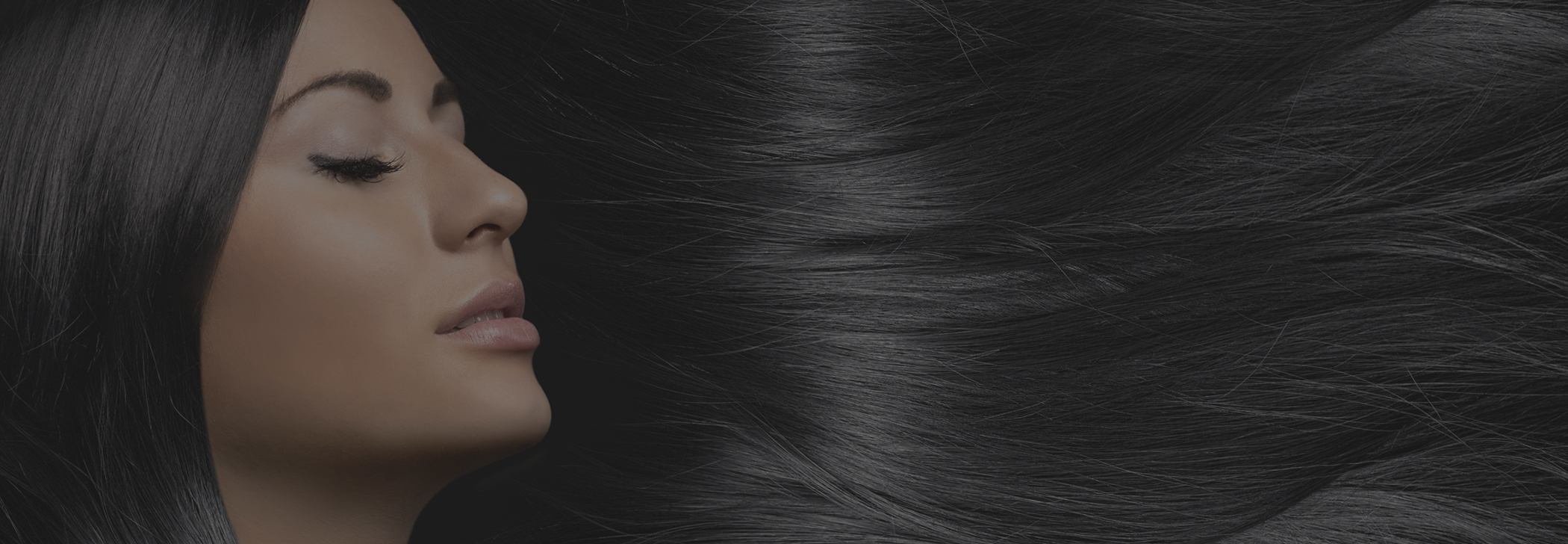
What Is Soft Rebonding?
From silver screen celebrities to Instagram influencers, straight hair has always been a popular style. But not everyone is blessed with easy-to-maintain tresses that fall silkily down their backs.
How you style your crowning glory can be a great way to express your individuality. So when your hair is hard to manage, it can often get in the way of your self-expression. Depending on what you are trying to achieve, there is an option for everyone to get this look:
- Blow-drying
- Straightening with a flat iron
- Relaxing
- Rebonding
Every method has its pros and cons but hair rebonding gives you the ultimate straightening effect. By comparison, both blow-drying and straightening with a flat iron require you to invest more time and effort on a daily basis.
Rebonding has also evolved over time. More variations of this technique have surfaced, and soft rebonding is now one of the most popular treatments out there for good reasons. Keep on reading to find out more about straight and soft rebonding treatments, the difference between the two, and how you can manage your new sleek style.
What Is Rebonding?
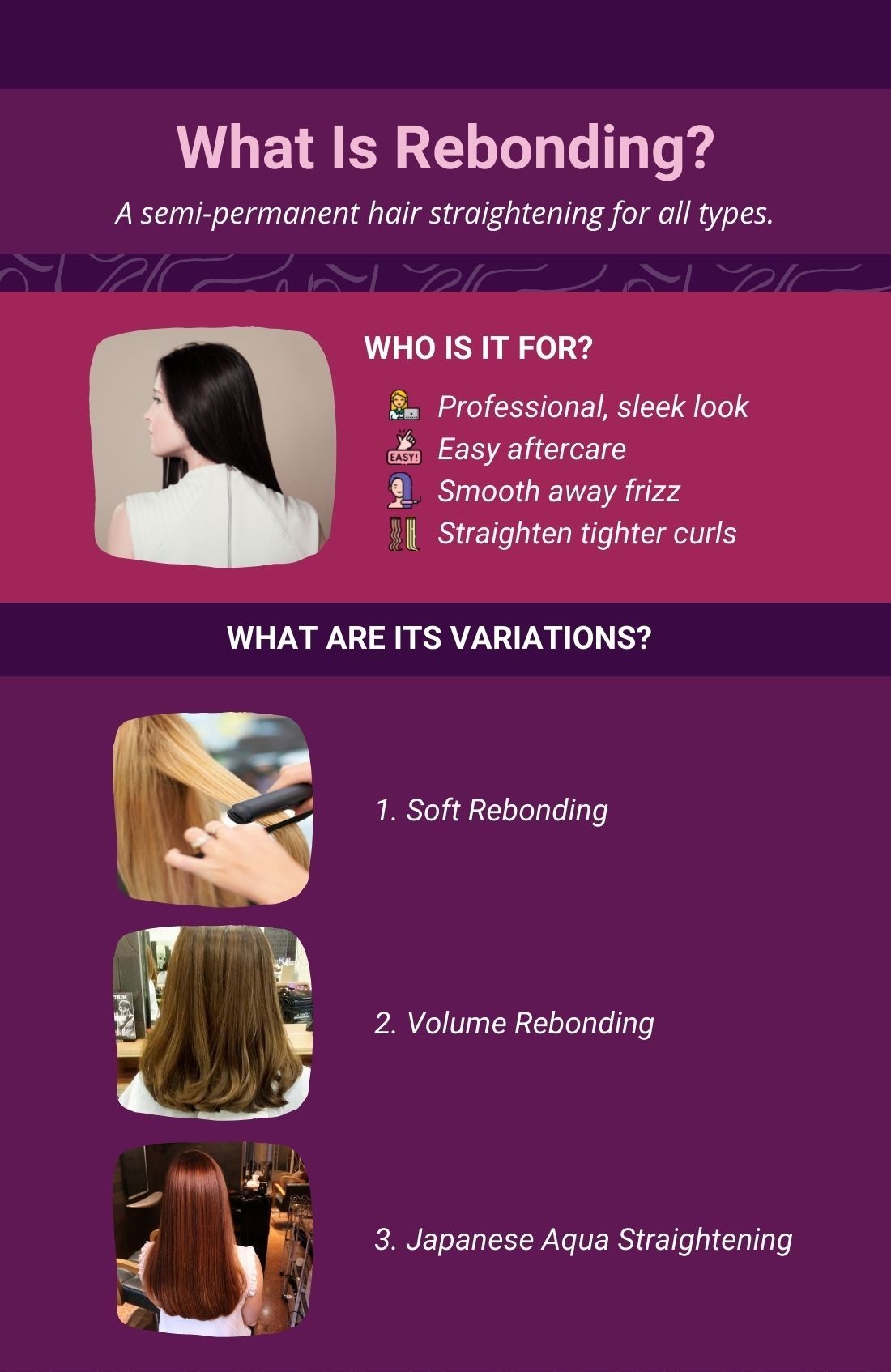
Developed in Japan in the year 1996, rebonding became all the rage in Singapore in the early 2000s. While it initially hit like a storm, eventually the dust settled down. There was even a period of time when it even lost some popularity. However, as the years have gone by, updated and different variations of this treatment have cropped up, allowing this classic treatment to become popular once again.
Rebonding has withstood the test of time and proven that it’s here to stay. Here’s a short summary on what it is and why it’s so popular.
1. What Is It Exactly?
Rebonding is a chemical treatment that straightens all types of hair semi-permanently. It gets its name from the whole process where natural bonds in your strands are broken down, rearranged into a straight structure, and rejoined together by stopping the process with a neutraliser. Hence the name ‘rebonding’.
2. Who Is It For?
The good news is, anyone can undergo this treatment. Both men and women look to this technique to smoothen their frizzy, coarse, or unmanageable tresses. Others prefer this process as it makes for fairly easy aftercare and the end result is professional but sleek. Individuals with a very strong curl pattern may also choose this option as straightening of tighter curls requires heavy-duty chemicals.
3. What Are Its Variations?
While this is the original technique, time and technology have given birth to many similar straightening methods that yield different results. Here are the different types of treatments at a glance:
- Soft Rebonding
- Volume Rebonding (C Curl; S Curve; Rebonding Perm; Styling Perm)
- Japanese Aqua Straightening
What is Soft Rebonding?
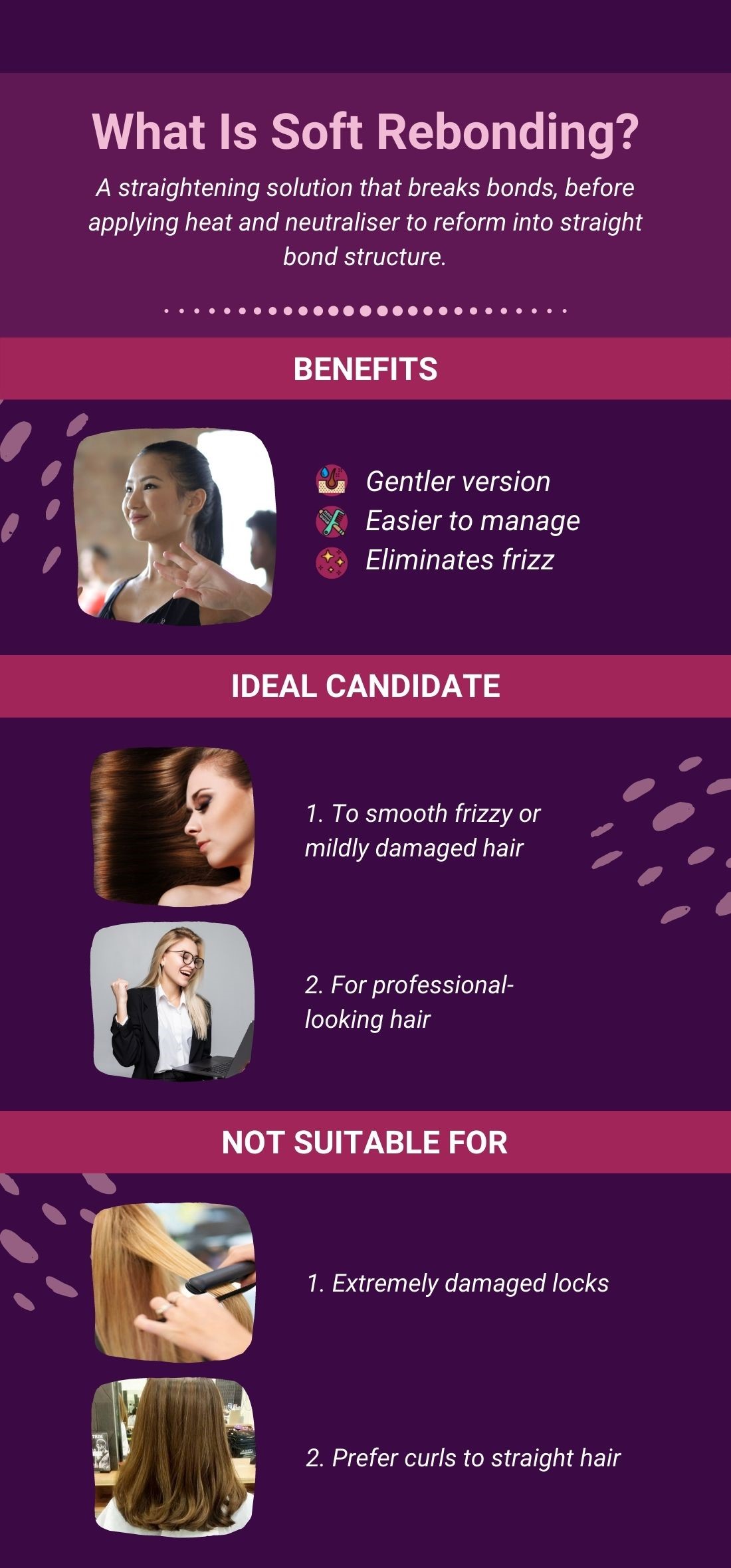
Soft rebonding is the direct descendant of the original straight version. It rose to popularity shortly after the introduction of the original treatment in Singapore. A major reason for its popularity is its final outcome. Individuals enjoy sleek, shiny tresses that do not compromise on volume and are not too strict in appearance.
1. What Is The Process?
Any salon worth its salt will first invite you to a consultation session before your actual appointment begins. After assessing your hair, the professionals will inform you about its condition and whether it is possible to proceed with your treatment of choice. During your appointment, your locks will be combed out and divided into sections. Next, a powerful straightening solution will be applied to the strands evenly. This lotion breaks down the natural bonds in your strands. Then, either using a flat iron or a steamer, heat is applied to your locks to rearrange the bonds into a straight structure. Finally, a neutraliser is added to your locks to reunite the bonds. Serum is then applied to your tresses to give them the protection they need.
2. Who Is An Ideal Candidate?
Similar to its predecessor, anyone can choose to go through this process. There is no preferred candidate, however, this straightening method tends to be the solution for individuals who would like to smoothen and straighten their frizzy or mildly damaged hair. With this method, tresses become sleeker but still retain some of their own liveliness, similar to having gone for a blow-dry. This look is ideal for someone who would like professional-looking tresses while still looking natural.
3. What Are Its Benefits?
This process has many benefits, including the following:
- Gentler version of the original process
- Enables easier hair management
- Leaves strands that grow out unaffected by the chemical process
- Straightens hair while allowing natural movement
- Eliminates frizz
- Relaxing experience
4. Who Is This Not Suitable For?
Naturally, applying chemicals and heat to hair can be damaging, which makes this less than ideal for anyone with extremely damaged locks. Speak to your stylist to ensure that the process would be safe for yours. It may be possible to proceed when complemented with the right hair treatment. However, soft rebonding may not be for you if you prefer more curl to your locks. You may look into other options, such as getting the perfect haircut alongside a professional keratin treatment to manage your natural waves.
Straight vs Soft Rebonding: What’s the Difference?
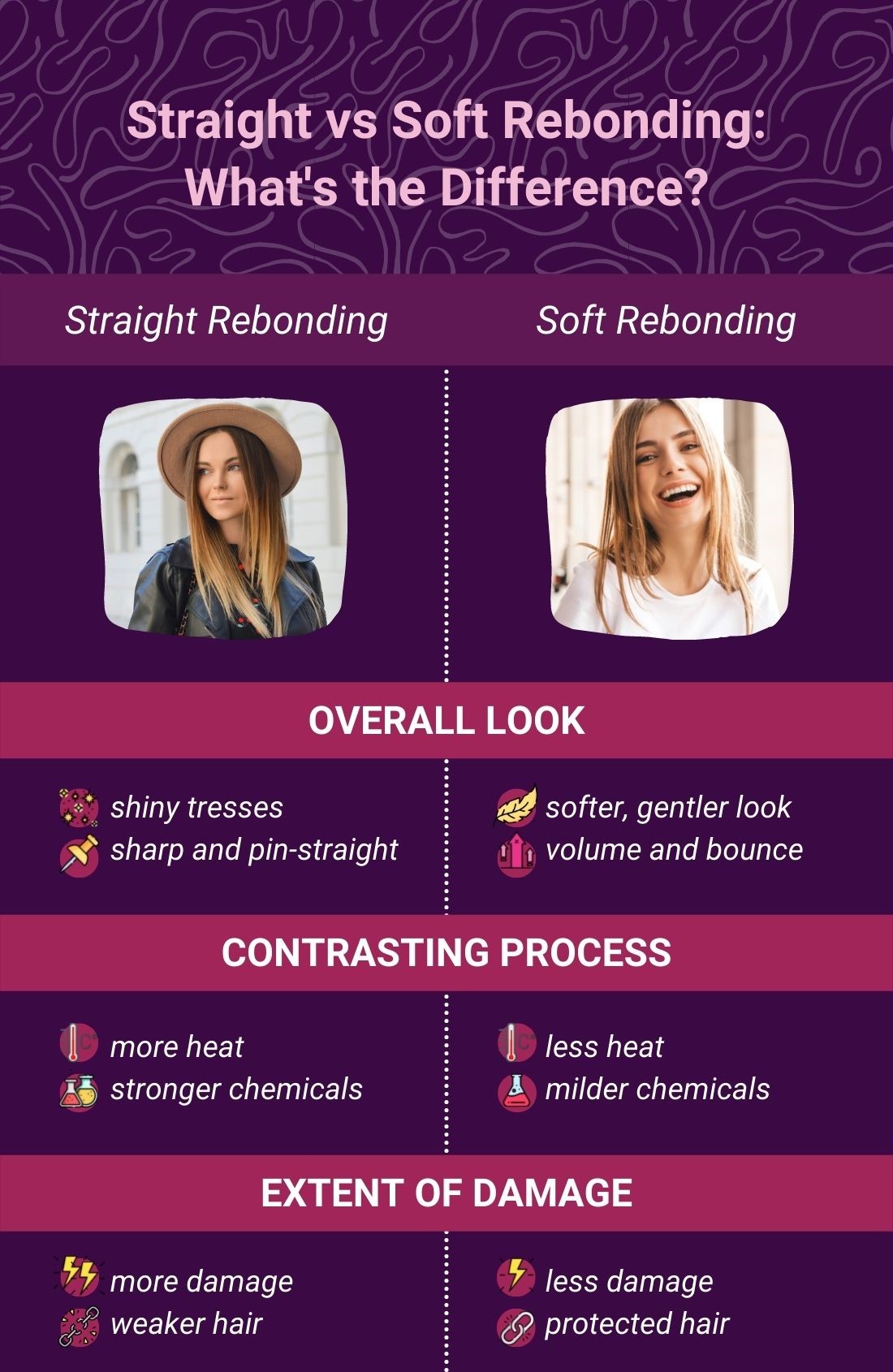
Before making any big decisions about your hair, you should ensure you have sufficient knowledge of the treatments you are considering. Upon reading the top two sections, you might have come to the realisation that both treatments are fairly similar. However, they do come with subtle differences that might lead you to pick one over the other.
1. Overall Look
As some individuals consider their hair a part of their identity, you should want to make sure the process you select will result in a look that is compatible with your selfhood. One key difference between these two treatments is the overall look they produce. With the original method, you can expect shiny tresses with a sharp and pin-straight look. However, as everyone has different face shapes, its sleekness may not frame their face how they might prefer for themselves. While the motivation of both treatments are the same, the outcome of the soft technique is contrasting. A softer and gentler overall look is achieved and while hair is tapered down and frizz-free, volume is not completely compromised. Your locks will still retain some bounce and natural movement.
2. Contrasting Process
Both processes consist of identical steps, but there are distinctions in the process and chemicals used. For a soft straightening treatment, there is less use of heat. It also uses milder chemicals on the hair to achieve a smooth but more natural look. Unlike that, the original method uses stronger chemicals as well as both longer and heavier applications of heat.
3. Extent of Damage
Since straight rebonding uses more heat and stronger chemicals, it may cause more damage to your hair. Heat causes damage to one’s locks by stripping them of moisture, causing them to become dry and brittle. Soft rebonding, in turn, uses lower temperatures, therefore lessening damage from heat. Harsh chemicals utilised in the original rebonding are also guilty of harming your tresses, leading to weaker hair and easy breakage. By comparison, soft rebonding uses chemicals that are less harsh. While both treatments may damage the locks, the soft method is gentler.
How to Care for A Soft Rebond
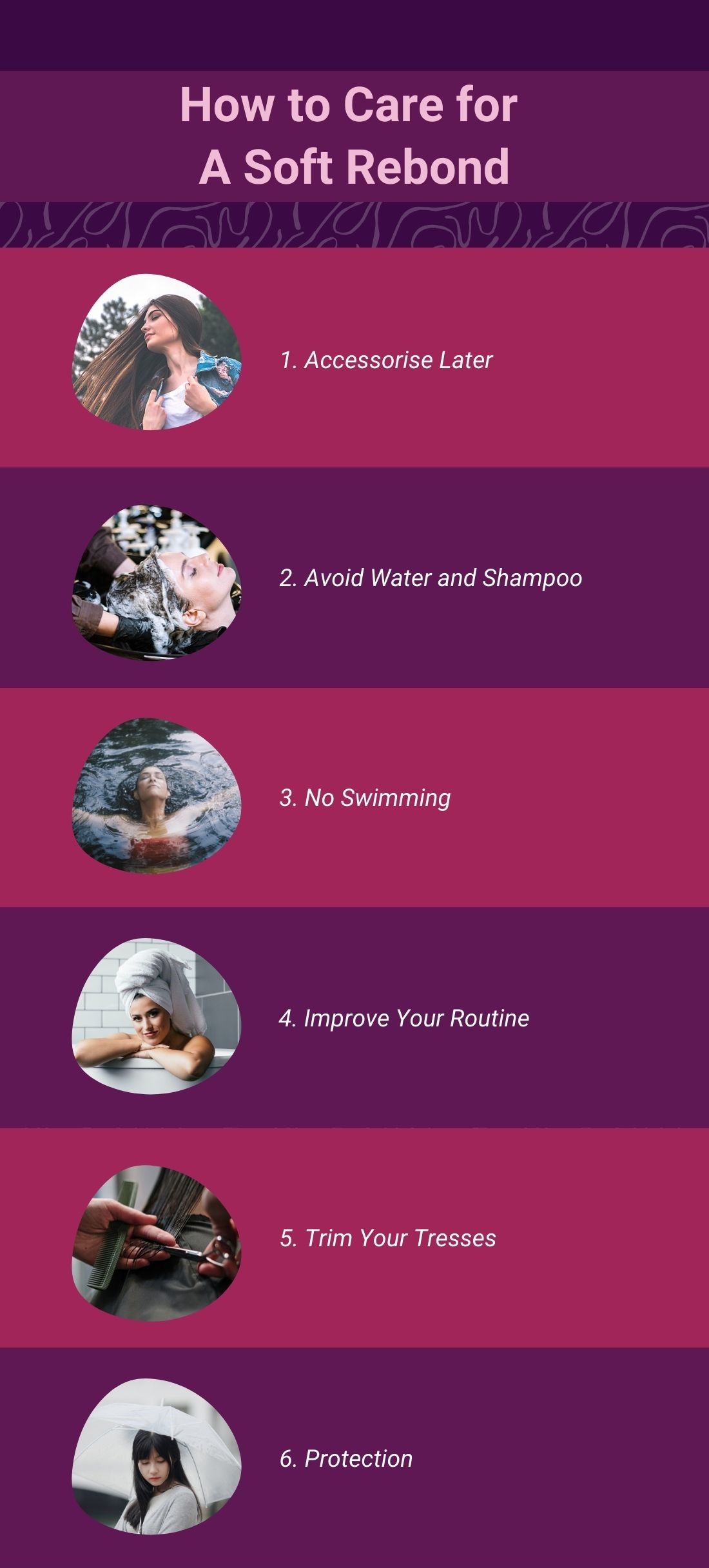
When you undergo chemical treatment, you have to ensure you take the right steps to care for your precious locks afterwards. Aftercare is essential to caring for your new gorgeously tame tresses and minimising the chances of damaging them.
Despite your locks looking shiny and frizz-free, pampering them after this process is key to maintaining the effects of soft rebonding.
Here are six ways you can treat your hair after this process:
1. Accessorise Later
Bid adieu to hair accessories such as bobby pins, hair ties, clips, and hair bands temporarily. Newly straightened locks need to stay straight for them to get used to the new structures. Accessories can cause creases and folds in your straightened locks, and even tucking your strands behind your ears can wrinkle your tresses. Additionally, you want to ensure you sleep with your tresses untied to maintain their shape. After a month, you can start reintroducing accessories but avoid tying your hair for long hours or pulling it too tightly.
2. Avoid Water and Shampoo
Singapore is a humid country. On days when the temperatures skyrocket well into their thirties, you might be tempted to take a head-to-toe shower. However, with freshly treated tresses, getting them wet can affect the results as it requires approximately three days to set. Avoid wetting or washing it for 72 hours post-treatment. This includes postponement of your workouts as your scalp also sweats. If you’re wondering how you can take a shower, purchase a shower cap and gently tuck your hair into it without tying. Once your hair quarantine period is up, wash with cool water as well as mild shampoo and conditioner.
3. No Swimming
Getting your hair wet can negatively impact your freshly treated locks, but damage can worsen when water is combined with either chlorine or saltwater. Wait a minimum of two weeks before swimming. It’s better to hold off and reschedule that swim session in the pool or at the sea instead of impairing the quality of your soft rebond. Both chlorine and saltwater are harsh to your locks, causing them to dry out and become brittle. If you’re planning for a beach vacation, try to schedule your appointment at least a month before your trip.
4. Improve Your Routine
Infusing your hair with chemicals to restructure its bonds sounds taxing for your tresses. And it is! By choosing to undergo a chemical treatment such as this, your hair care routine needs to improve. Opting for shampoos and conditioners that are gentle on chemically treated locks are a must as these products help nourish and moisturise your tresses. Consider deep conditioning treatments like hair masks as they help provide protein for healthier tresses.
5. Trim Your Tresses
You should also ensure you get your tresses professionally trimmed at your salon every six to eight weeks. A lack of moisture, among other factors, can cause damage like split ends. When neglected, split ends can travel up the shaft of your strands, ultimately damaging the entire strand.
6. Protection
Things such as pollution and UV rays have a tendency to harm rebonded hair. Even though pollution in Singapore is not awful, according to an article in the Today Newspaper in 2020, Singapore has yet to meet air quality goals set by itself. On top of that, on most days, the little island country faces extremely high UV indexes. Avoid the sun and environmental pollutants by using scarves, hats, or umbrellas. You should also avoid styling your locks with heat, and consider in its place products such as gel or mousse. If you must use a blowdryer, use one that has a cool setting.
The Final Takeaway
While there are many different techniques and methods to straighten your hair, you should always pick the one that is most suited to your lifestyle and, of course, one that you like. Soft rebonding is an excellent choice for people on the go. Individuals who do not want to spend too much time taming their mane and would like to have frizz-free tresses should opt for this treatment.
Should you select this as your treatment of choice, ensure you go through a consultation with your salon before setting an appointment date. Do note that this technique often takes at least three hours to complete (and this is if you have shorter hair). So, equip yourself with water, snacks, and a power bank for your mobile phone to keep yourself occupied and you’re good to go!


